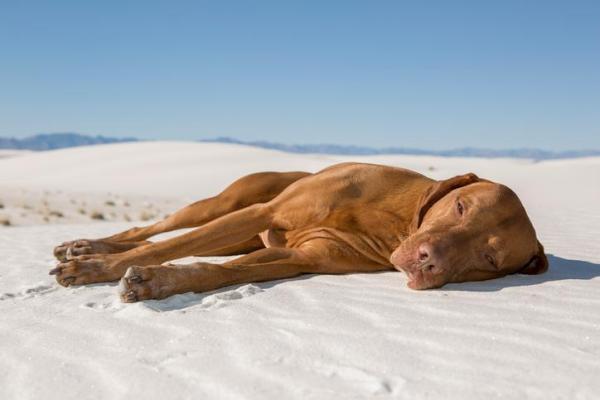
Dehydration is a condition that does not only affect humans, but animals too. Dehydration in our dogs can appear due to many different causes. Dehydration has different degrees of severity. It is incredibly important that dog owners are familiar with the signs and symptoms of dehydration in dogs. Dehydration can be very dangerous and in severe cases it can be potentially fatal. For this reason, in this AnimalWised article we will discuss necessary symptoms and treatment, and ultimately tell you how to know if your dog is dehydrated.
Causes and symptoms of dehydration in dogs
Dehydration occurs when a dog eliminates more fluids than it recovers. This causes an imbalance of fluids and electrolytes in its body. This condition can affect the entire function of a dog’s organism. If a dog is suffering from a severe case of dehydration, it can sometimes even put its life in danger.
There are multiple causes of dehydration in dogs. However, dehydration in dogs is most often associated with diseases in which fluids are lost through vomiting and/or diarrhea. Thus, whenever a dog is losing a lot of fluids, you should pay attention to its hydration levels. Other pathologies, such as kidney disease and heat stroke, can also produce this imbalance. In addition, fever and serious illnesses can cause a reduction in a dog’s water intake, in turn, leading to dehydration.
In order to know if your dog is dehydrated, you can follow a list of sample checks. These tests include; lifting the skin on the back of your dog’s neck (or between the shoulder blades). You carefully separate the skin from the body by a few centimeters, then release it. In a healthy dog the skin regains its shape instantly. If your dog is dehydrated its skin takes time to return to its normal position. The more time it takes, the more dehydrated your dog is. This action samples elasticity in the skin, elasticity which is driven by fluid in the dog’s body. There are other ways to tell if your dog is dehydrated, these include:
- Dry gums
- Thick saliva
- Darkened urine
- Sunken eyes (In more serious cases)
- Lethargy and/or anorexia.
Types and degrees of dehydration in dogs
Keep in mind that dehydration is a state that will not simply reverse itself if you give a dog a bowl of water. Unless it is a case of mild dehydration, more intense measures should be taken. As we mentioned before vomiting, diarrhea or some diseases are the most common causes of dehydration in dogs.
If you observe signs of dehydration in your dog, we recommend going to a veterinarian to establish a precise diagnoses and corresponding treatment. There are different types of dehydration in dogs, known as; isotonic, hypertonic and hypotonic dehydration. These forms of dehydration depend on the amount of water that is lost in relation to the solutes in the body, as dehydration also results in an electrolyte imbalance. The degree of severity in a dehydration case can be measured:
- Less than 4% dehydration: is the mildest case and we will not notice any evident symptoms.
- Between 5-6%: with this percentage you will see that, if we check the skin, the fold takes a little time to recover.
- Between 6-8%: in this situation dehydration is evident, and the fold of the skin will take time to recover itself.
- Between 8-10%: besides a delay in the skin test, you might notice dry mucous membranes around the dog’s nose and sinking of its eyeballs.
- Between 10-12%: in addition to the above mentioned symptoms, a dog will start to go into shock and you might see pale mucous membranes, among other symptoms.
- Between 10-15%: at this stage the shock will already be severe and the dog is in danger of imminent death. More than 15% of dehydration is considered incompatible to living.

My puppy is dehydrated
Some dogs are more prone and vulnerable to dehydration, specifically puppies or older dogs. If you believe that your puppy is dehydrated, we suggest going to a veterinarian as soon as possible. The smaller the puppy, the higher its risk when it comes to dehydration. Dehydration in a puppy can escalate at an incredibly fast rate and can lead to death if not addressed immediately. A dehydrated puppy will have a dry mouth and you can test this by offering the puppy your finger. They will also appear weaker than normal and their skin fold will not regain shape.
Therefore, if an puppy suffers from diarrhea, the most common cause of dehydration, you should seek immediate veterinary assistance.
How to treat dehydration in dogs
If you notice signs of dehydration in your dog and a veterinarian confirms it, the most important thing is to determine its cause and establish an appropriate treatment. The aim of the treatment is to reverse damage and re-balance fluid levels in the dog’s body. Vets most commonly replenish these fluids by administering a fluid or electrolyte medical drip.
In mild cases, a serum can be prescribed subcutaneously, through skin injections or oral syringes. When the administration is intravenous, a dog will need to be hospitalized for about 24-48 hours. The amount of serum, fluid or electrolytes that need to be administered should be confirmed by your vet. This quantity will depend on both the severity of the case and the age/weight of the dog.
If, for whatever reason, it is an emergency situation and you do not have access to a veterinarian, you can prepare a homemade solution, although it will still be mandatory to go to the specialist as soon as possible.

How do I hydrate my dog?
As we have already mentioned, dehydration of a dog, except in very mild cases, cannot be solved by simply offering them a bowl of water. You can however, follow a series of measures to prevent your dog suffering from dehydration:
- Always ensure that your dog has a good supple of clean and fresh water. This is especially important on hot days. If you are going to work or will not be at home, you need to make sure that its water bowl or drinker cannot be accidentally knocked over.
- Never leave a dog in a car, especially when it is very hot outside. If you are spending the day outside, make sure you offer your dog some shade. We also suggest, if you want to exercise your dog in the summer, that you choose to do this in the coolest hours of the day, for e.g.:the morning and evening.
- If our dog has a disease that increases their risk of dehydration, such as kidney disease, encourage your dog to drink more water than normal. You can do this by offering them flavored broths or ice cubes to lick. You can also feed them wet food to increase their liquid intake.
- In addition, if you observe any of the symptoms of dehydration in your dogs consult your veterinarian as soon as possible, especially if your dog is a puppy, old or is suffering from a disease.
- If your dog is showing these signs, you can at first offer them water and keep track on if they recover. If they are not presenting any signs of vomiting, keep them in the shade for a while, as they might be suffering from heat stroke.
This article is purely informative. AnimalWised does not have the authority to prescribe any veterinary treatment or create a diagnosis. We invite you to take your pet to the veterinarian if they are suffering from any condition or pain.
If you want to read similar articles to Signs My Dog Is Dehydrated, we recommend you visit our First aid category.